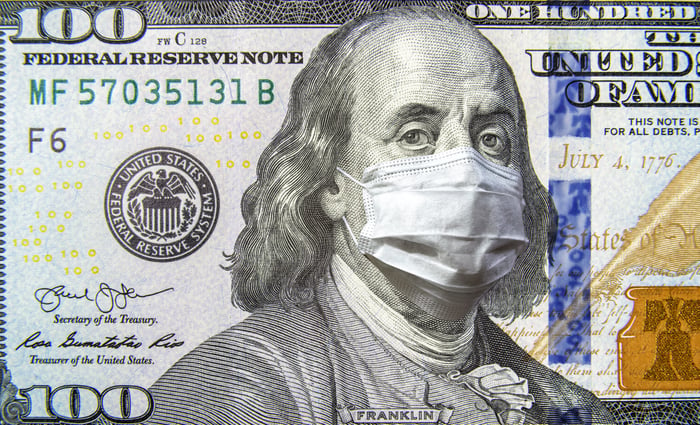At one point, it looked like the U.S. was getting a handle on the COVID-19 outbreak. Consumers celebrated as lockdowns began to ease and Main Street businesses began the process of gradually reopening.
Unfortunately, it didn't last and there's been a spike in the number of new coronavirus cases with some states reporting record hospitalizations and fatalities in July. At the same time, the U.S. has maintained its status as the worldwide epicenter for new COVID-19 cases. As a result, a number of states and municipalities are looking to reimpose stay-at-home orders in an effort to contain the outbreaks.
Fortunately, investors looking to hedge their bets to account for the inevitable economic downturn can invest in companies that have already proven to be resilient against the shelter-in-place orders while also providing upside for the future.
If you've got $5,000 (or less) and you don't need it for immediate expenses or to supplement your emergency fund, consider putting it to work in these three companies that stand to gain even if there's another round of lockdowns.

Image source: Getty Images.
1. Activision Blizzard: Winning the game
The past decade saw a well-documented and meteoric rise in the popularity of video games. This phenomenon accelerated with the proliferation of free-to-play mobile games and the battle royale genre that gained traction in recent years, even as esports experienced broader adoption. Widespread stay-at-home orders sent both novice and experienced gamers running for their favorite pastime, while also attracting new players. Activision Blizzard (ATVI) was particularly well-positioned to benefit from the first round of lockdowns and will, in all likelihood, continue its "winning" ways.
As consumers whiled away the hours at home, many sought refuge in Activision titles, including such top-selling franchises as World of Warcraft and Call of Duty, as well as free-to-play games like Candy Crush. The company released Call of Duty: Warzone in the first quarter and the free-to-play, battle royale game was a smash hit -- attracting 60 million players less than two months after its March 10 debut.
Activision reported first-quarter financial results that beat expectations by a country mile. The company delivered non-GAAP (adjusted) revenue of $1.52 billion, up 21% year over year, easily eclipsing analysts' consensus estimates of $1.32 billion. If you think that's impressive, consider this: Activision's adjusted earnings per share of $0.76 beat expectations by 100%.
With no end to the pandemic in sight at this point, consumers continue embracing in-home entertainment choices, and Activision Blizzard is a solid choice for the investors who want to play the game.

Image source: Amazon.
2. Amazon.com: Accelerating the transition to e-commerce
Even before the pandemic, online retail was becoming a fact of life for a growing number of consumers. But as the coronavirus spread like wildfire and lockdowns became the order of the day, e-commerce quickly became indispensable for shoppers avoiding brick-and-mortar retail for fear of contracting the virus. As the world's largest digital retailer, Amazon.com (AMZN -1.65%) became a lifeline for those unable or unwilling to leave the house. Many of those shoppers have likely become lifelong converts because once they've experienced the ease and convenience of online shopping, there's simply no going back.
It's not just its e-commerce operations that made Amazon stock a no-brainer in light of additional shelter-in-place orders. The shift to remote work accelerated the digital transformation, with many businesses turning to Amazon Web Services to meet their cloud-computing needs. That trend is likely to continue as many companies embrace remote work as the pandemic drags on.
That's not all. To pass the time during lockdowns, people turned to streaming for their listening and viewing needs. Movie and television buffs turned to Amazon Prime Video, while music lovers tuned in to Prime Music.
For the first quarter, the tech giant reported revenue that grew 26% year over year, the fastest pace of growth the company has produced since the third quarter of 2018. Profits took a hit as Amazon hired additional workers to meet the unprecedented demand, and those costs are expected to continue into the current quarter, with Amazon projecting COVID-19-related expenses nearing $4 billion.
As the country begins to impose additional restrictions, Amazon stands to gain from the growing adoption of e-commerce, cloud computing, and streaming video and music, easily earning a spot on the "no-brainer" list.

Chris Hemsworth in a scene from the Netflix original movie Extraction. Image source: Netflix.
3. Netflix: There's plenty to watch
One of the consistent refrains from Netflix (NFLX 1.74%) bears was the company's insistence on spending like a drunken sailor to increase its library of streaming video programming. That weakness turned into a strength as the pandemic shut down movie and television production facilities around the world. Not only did the streaming pioneer have its existing shows to fall back on, but it had already completed production for most of its slate of releases for 2020, and had filming in the can for next year's batch of programs.
Netflix's never-ending catalog of content was no doubt one of the main factors that attracted stay-at-home viewers to the platform in record numbers in the first quarter. Subscriber growth accelerated to 26% year over year as the company added a record 16 million customers. Revenue grew 28%, while net income surged by more than 100%. In an unexpected turn of events, Netflix's free cash flow climbed into the black, though that isn't expected to last once movie and television production resumes.
But it's the company's international opportunity that should excite investors, lockdowns or not. Netflix ended last year with more than 61 million subscribers in the U.S. or about half the households in the country. On the international stage, however, Netflix has only achieved a penetration rate of about 7% (excluding China, where the company only licenses its content).
If it were able to duplicate its U.S. success worldwide, Netflix could add another 600 million subscribers, according to Piper Sandler analyst Yung Kim. At more than three times its current customer count of 182 million, Netflix still has a long road ahead, even after the pandemic is finally contained.
Data by YCharts.
Winners keep winning
A quick look at the stocks chart illustrates just how successful these companies have been during the recent lockdowns. The Dow Jones Industrial Average is down 6% and the S&P 500 is sitting near breakeven, while the NASDAQ Composite is up about 17% year to date. At the same time, Activision, Netflix, and Amazon have gained 33%, 62%, and 63%, respectively, crushing the returns of the broader market.
Winners tend to keep winning, and even in the event of additional stay-at-home orders, these companies offer the goods and services that consumers will turn to in their hour of need.






